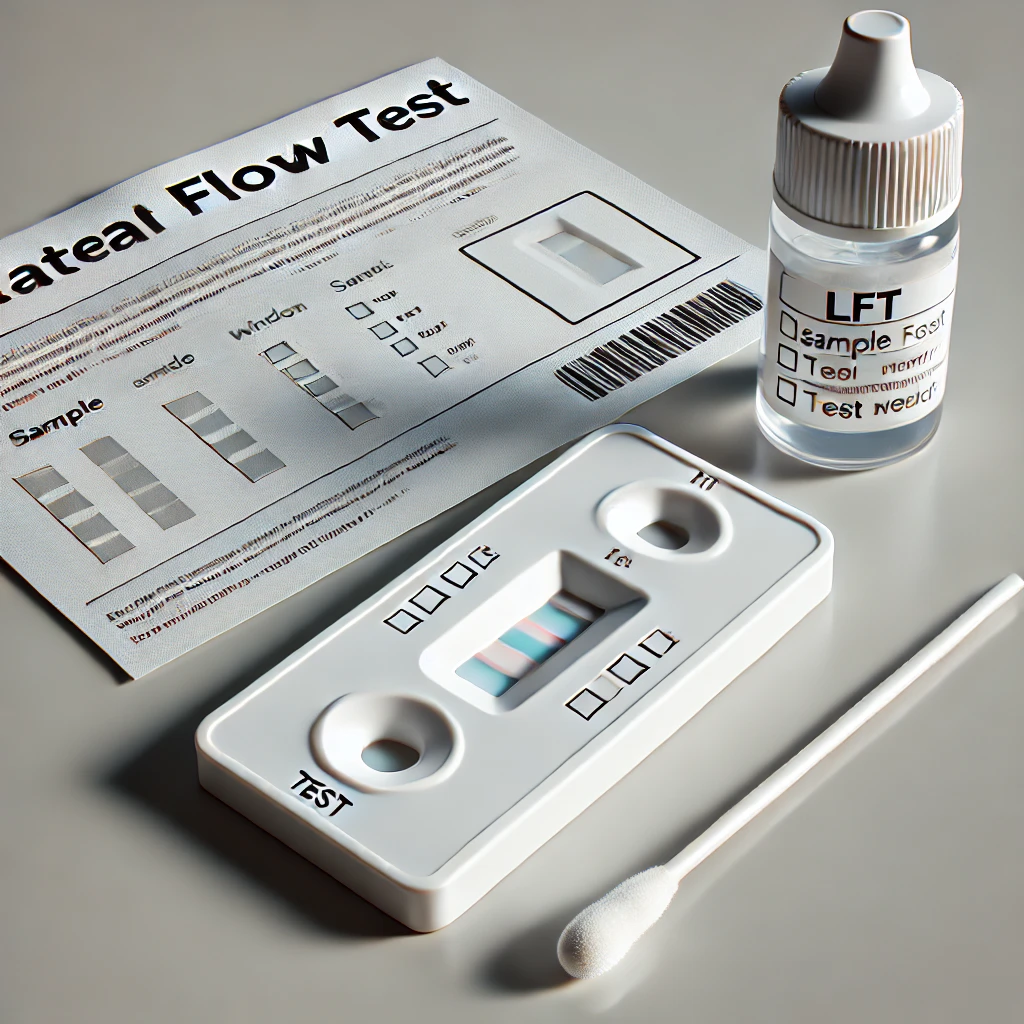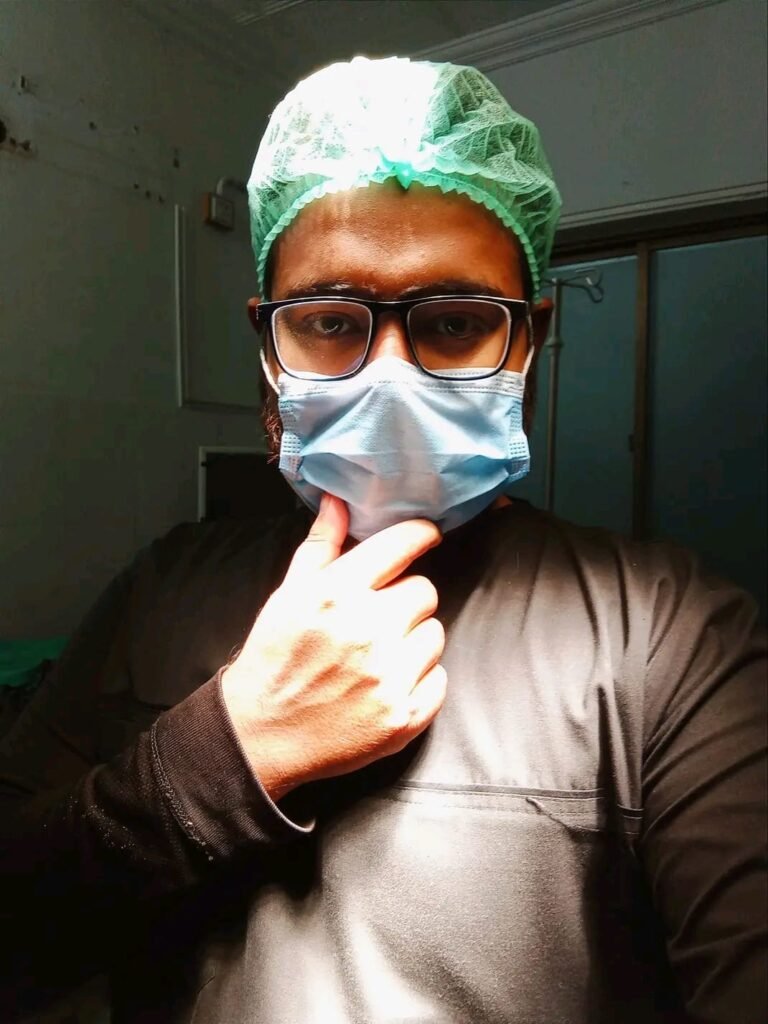Table of Contents
A Lateral Flow Test (LFT) is a simple diagnostic test used to detect the presence or absence of a target substance, such as viruses, bacteria, hormones, or biomarkers, in a liquid sample. It is commonly used in pregnancy tests, COVID-19 tests, and disease diagnostics because it is fast, portable, and easy to use.
Lateral Flow Test (LFT) – Introduction to Lateral Flow Test (LFT)
A Lateral Flow Test (LFT) is a paper-based device designed to detect a specific substance in a liquid sample (such as saliva, blood, or urine).
It works by using capillary action, meaning the liquid moves across the test strip without needing external power.
A Lateral Flow Test (LFT) is a rapid, immunochromatographic assay used to detect specific molecules (antigens, antibodies, nucleic acids, or biomarkers) in biological samples. It is widely used in point-of-care (POC) diagnostics due to its low cost, speed, and ease of use.
✔️ First introduced: 1980s
✔️ Time to result: 5–30 minutes
✔️ Detection limit: 1–100 pg/mL (depends on target analyte and method used)
✔️ Market size (2023): $10.2 billion (expected to reach $13.8 billion by 2028)
✔️ Major applications: Infectious diseases, pregnancy, drugs, food safety, veterinary diagnostics
Examples of Lateral Flow Tests in Real Life:
✔️ Pregnancy test (detects hCG hormone in urine)
✔️ COVID-19 antigen test (detects virus proteins in saliva/nasal swab)
✔️ Drug tests (detects drugs in urine)
✔️ Food safety tests (detects bacteria like Salmonella)

Structure & Working Mechanism of Lateral Flow Assay
A Lateral Flow Assay (LFA) consists of four main components:
(i) Sample Pad
- Material: Glass fiber or cellulose
- Function: Absorbs the sample and ensures smooth flow
- pH range: 6.0–8.0 (ideal for most biological samples)
(ii) Conjugate Pad
- Contains: Gold nanoparticles (20–40 nm) or colored latex beads
- Common antibodies used:
- COVID-19 tests: Anti-SARS-CoV-2 antibodies
- Pregnancy tests: Anti-hCG antibodies
- Malaria tests: Anti-Plasmodium antibodies
- Typical conjugation ratio: 1:1 (antibody:gold nanoparticle)
(iii) Nitrocellulose Membrane
- Pore size: 3–15 µm
- Flow rate: 4–12 mm/min
- Binding capacity: 80–120 µg/cm² (for proteins)
- Test line sensitivity: As low as 1 ng/mL
- Control line sensitivity: Typically higher (5–10 ng/mL)
(iv) Absorbent Pad
- Material: Cellulose or polyester
- Function: Absorbs excess liquid
- Volume capacity: Up to 200 µL
Detection Principles in Lateral Flow Tests
LFTs use three main detection principles:
| Detection Method | Sensitivity | Detection Range |
|---|---|---|
| Colorimetric (Gold Nanoparticles) | Moderate (1–100 ng/mL) | 1–100 ng/mL |
| Fluorescence (Europium Nanoparticles) | High (0.01–10 ng/mL) | 0.01–10 ng/mL |
| Electrochemical (Graphene-based Sensors) | Very High (0.001–1 ng/mL) | 0.001–1 ng/mL |
Common Labels Used in LFTs
- Gold nanoparticles (20–40 nm, red color)
- Quantum dots (~10 nm, fluorescence-based)
- Europium nanoparticles (200–300 nm, fluorescence-based)
- Enzyme-based detection (horseradish peroxidase, alkaline phosphatase)
Sensitivity & Specificity of Lateral Flow Tests
- Sensitivity: Ability to detect the target substance (true positive rate)
- Specificity: Ability to exclude non-target substances (true negative rate)
| Test Type | Sensitivity | Specificity |
|---|---|---|
| COVID-19 antigen test | 60–98% | 97–99% |
| Pregnancy test (hCG detection) | >99% | >99% |
| HIV antibody test | 92–99% | >99% |
| Malaria antigen test | 85–97% | 98–99% |
Factors Affecting Sensitivity:
✔️ Sample type: Blood, saliva, urine (blood has highest sensitivity)
✔️ Storage conditions: 4–25°C (higher temperatures degrade sensitivity)
✔️ Membrane pore size: Smaller pores = better sensitivity
How to Read the Results?
After a few minutes (usually 5–30 minutes), you check the strip:
🔴 Two lines (T & C): Positive result → The substance is present.
⚪ One line (C only): Negative result → The substance is not present.
⚠️ No lines or only T line: Invalid result → The test failed.
How to Improve Accuracy of Lateral Flow Tests?
✔️ Follow instructions carefully
✔️ Use a proper sample (not contaminated)
✔️ Store tests properly (avoid heat, moisture)
✔️ Confirm results with other tests if needed
Clinical Performance & Comparison with PCR Tests
| Feature | Lateral Flow Test (LFT) | Polymerase Chain Reaction (PCR) |
|---|---|---|
| Detection Limit | 1–100 ng/mL | 1–10 fg/mL |
| Time to Result | 5–30 min | 2–8 hours |
| Sensitivity | 60–98% | 98–100% |
| Specificity | 97–99% | >99% |
| Cost | $1–$5 per test | $50–$150 per test |
| Usage | Home & field use | Laboratory only |
Regulatory Approvals & Standards
✔️ FDA Approval Requirements:
- Sensitivity >80%
- Specificity >95%
✔️ ISO Certification: - ISO 13485: Quality management for medical devices
- ISO 15189: Accreditation for diagnostic labs
✔️ European CE Marking: - Required for sale in the EU
Storage & Stability of Lateral Flow Tests
- Ideal Storage Temperature: 4–25°C
- Shelf Life: 6–24 months
- Humidity Sensitivity: <50% RH (high humidity reduces accuracy)
Advantages of Lateral Flow Tests
✅ Fast results (within minutes)
✅ Easy to use (no special equipment required)
✅ Portable (can be used anywhere)
✅ Cost-effective
✅ No need for lab professionals
Limitations & Challenges
🚨 Limitations of LFTs:
❌ Lower sensitivity than PCR (risk of false negatives)
❌ Interference from food, medications, or contaminants
❌ Limited multiplexing ability (detecting multiple targets in one test)
🚀 Ongoing Research & Improvements:
✔️ AI-based analysis (scanning LFTs with smartphones for higher accuracy)
✔️ CRISPR-based detection (for ultra-sensitive tests)
✔️ Graphene-based electrochemical sensors (for better signal detection)
Common Uses of Lateral Flow Tests
- Medical diagnostics: COVID-19, pregnancy, malaria, HIV
- Food & water safety: Detecting toxins, bacteria
- Drug testing: Checking for banned substances
- Environmental testing: Detecting contaminants
Future of Lateral Flow Technology
📌 Market Growth: Expected to grow 8.2% per year (CAGR) from 2023 to 2028
📌 Emerging Applications:
- Early cancer detection (biomarker-based LFTs)
- Rapid sepsis diagnostics (CRP/procalcitonin tests)
- Environmental monitoring (toxin detection in water)
Final Summary (Key Numbers to Remember)
📌 Detection limit: 1–100 ng/mL (varies by method)
📌 Sensitivity: 60–99% (depends on test type)
📌 Specificity: >97%
📌 Time to result: 5–30 minutes
📌 Storage temperature: 4–25°C
📌 Shelf life: 6–24 months
📌 Cost per test: $1–$5
About Author
I’m Ayesha Iqbal, a student studying MBBS at Services Institute of Medical Sciences (SIMS) Lahore. I write about health for “GenZ Cares” because they care a lot about young people staying healthy. I do research and try new things to learn more about how to keep everyone feeling good. My articles focus on topics like nutrition, exercise, mental well-being, and ways to lead a healthier lifestyle. Through my writing, I aim to share valuable insights and practical tips that can make a positive difference in people’s lives.
Reviewed By

This article is reviewed by “Nashit Aliyan“, a certified Surgical Technologist from Government College University Faisalabad under section 2017-2021. I am 17A medical officer as well as Strategic and financial planning expert and Proficient in surgical field. Me and my team use the latest technology to perform complex surgical procedures. I recommend to “GenZ Cares” because they are really hardworking in their work and care a lot about youth to staying healthy.
